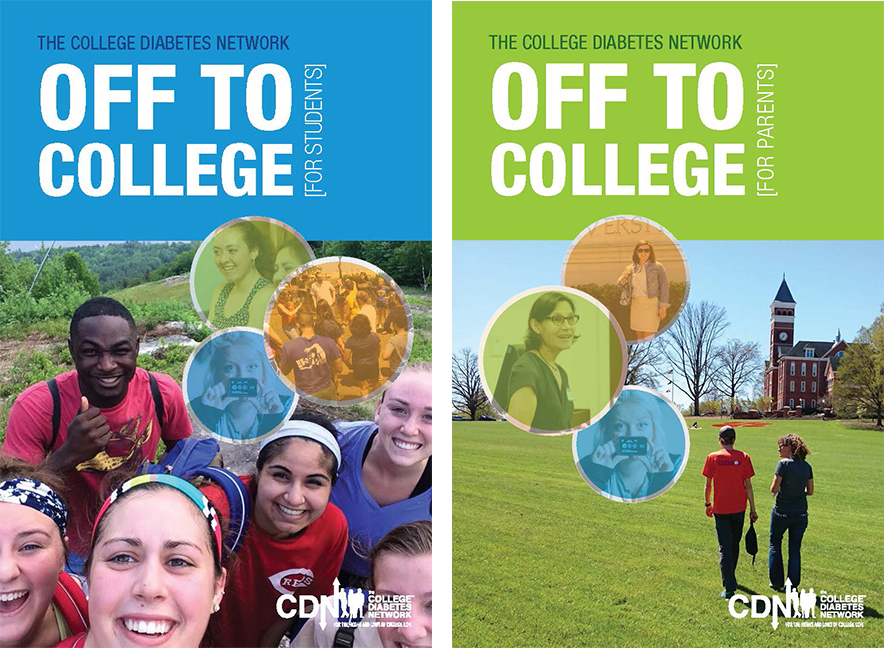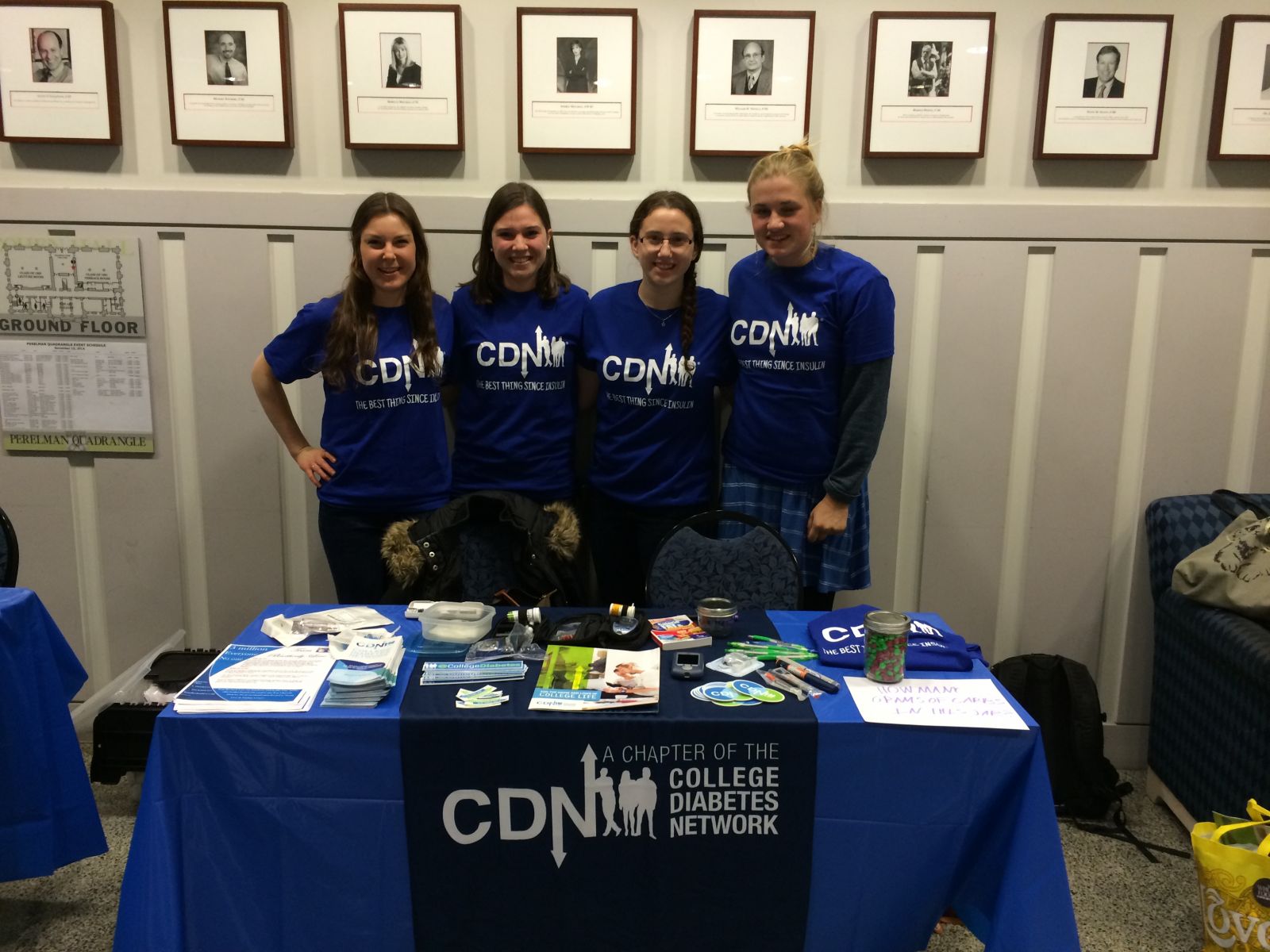Going Off to College and Have Diabetes? Learn Before You Go – Powered by College Diabetes Network
 By Ava Runge
By Ava Runge
College Diabetes Network’s free “Off to College” booklets on overcoming diabetes challenges during the college transition
As the summer comes to a close, thousands of young people with diabetes are packing their bags and preparing to head off to college for their freshman year. For many families, this exciting time is tinged with anxiety, stress, and fear about navigating diabetes in the college setting.
To guide young people and their families through this transition, the College Diabetes Network (CDN) recently published two fantastic “Off to College” booklets – one for students with diabetes and one for their parents – that are available online for free. The booklets discuss common challenges to expect when arriving on campus as a new student with diabetes (e.g., dining halls, erratic schedules, stress), as well as strategies for communicating with parents, preparing to move into dorms, finding a new doctor, registering for accommodations, managing sick days, sharing diabetes with friends and roommates, dealing with burnout, drinking alcohol with diabetes, entering the working world, and more.
As a recent college graduate with type 1 myself, I think these booklets offer an excellent foundation for college preparation and a much-needed framework for discussing college and diabetes among family members. While they are directed at new college students and their parents, they can also provide useful guidance for other life transitions, such as leaving home for boarding school, time abroad, or a new job. See below for five of my favorite tips from the CDN booklets, and please remember to check with your healthcare provider before making changes to your diabetes regimen (neither I nor the authors of the booklet are healthcare providers, though the booklets have been scientifically reviewed and approved by the American Diabetes Association).
1. Having ‘the talk’ with friends and roommates. CDN recommends explaining what your personal symptoms look like for high and low blood sugars, and teaching friends how they can help you. From personal experience, I have found that it can also be helpful to train your roommate and close friends on how to check your blood sugar and administer glucagon; their confidence in knowing they can help you during an emergency can offer better peace of mind for you both! When you’re getting to know someone new, there usually isn’t a perfect time to provide a “diabetes 101”, but I’ve found it is critical to create a support system that makes diabetes management easier, safer, and more convenient. It’s also one of the bigger challenges I faced in relation to my diabetes during freshman year of college.
2. Create a plan for your supplies. When I first arrived on campus, I realized that I had been so preoccupied with all my other college preparations that I had forgotten to transfer my prescriptions to a local pharmacy in advance. Before arriving on campus, the CDN booklets recommend addressing considerations such as: Where will you be getting your supplies from? Who will be ordering them? How will you know when to reorder? Where will you go to restock your low supplies and how will you get there? In addition, they advise packing backup supplies, having a plan for refrigerating insulin, and making preparations for supply storage and sharps disposal. My college transition may have been a bit less stressful for me (and my parents!) if I had addressed some of these questions earlier than I did.
Once I was at college, I set up an online subscription so that I always received my favorite low blood sugar supplies at a scheduled time – this helped me keep an easily-accessible stockpile of supplies and ensured that I never ran out. I also set up all my prescriptions at my university’s pharmacy so I didn’t have to leave campus to pick up supplies (I went to college in New England, so this was a legitimate concern during winter storms). Your supply preparation will vary depending on your school and personal preferences, but the more energy you can put into organizing a plan for maintaining your diabetes supplies, the more stress-free your day-to-day management will be.
3. Managing sick days. The CDN booklets very helpfully lay out the following helpful tips for safely managing diabetes while sick:
-
Make sure you have a friend who can check on you – you might need someone to bring you more low supplies, medicine, or help you get to the hospital if you are really sick.
-
Check your blood sugar often – at least every 2-3 hours.
-
Continue taking insulin, but adjust your basal/bolus rates as necessary.
-
Hydrate! Dehydration can be a risk factor for diabetic ketoacidosis (DKA), and it is more likely when you are sick.
-
Make a “Sick Day Ready Kit” (more details here).
-
Make a plan in advance with your healthcare provider and know when you need to call her or him for help.
When I was a freshman in college, I got a terrible stomach bug and ended up going to the emergency room because I couldn’t keep any food or drink down and my blood sugar was low. I would have seriously benefitted from making a plan with my healthcare provider beforehand so that I could safely manage my blood sugar while sick and save myself a trip to the ER – and save these costs from hitting our system.
4. Registering for Accommodations. According to CDN, many students with diabetes don’t register with the Disabilities/Auxiliary Services offices at their school – I was one of these students who didn’t register, but I wish I had. While it’s true that many of us don’t consider diabetes to be a “disability” at all, registering for accommodations can make managing diabetes during college a whole lot easier. The CDN booklet provides some reasons why:
-
If you don’t register with disability services, you aren’t guaranteed any sort of accommodations for problems that may arise due to your diabetes. For example, if you have to miss a test because of high or low blood sugar and aren’t registered for accommodations, your college likely won’t let you make it up. Of course, you very much hope this won’t happen, and it shouldn’t, but better safe than sorry!
-
Registering for accommodations also provides extra power that you can wield while advocating for yourself. Most professors will be accommodating, but if they aren’t, Disabilities Services can help you have food/drink in the classroom, use your diabetes technology, etc.
-
When needed, accommodations can also help with where you live, roommate situations, meal plans, and class registration.
I didn’t register with the Disabilities/Auxiliary Services office during college because I didn’t realize it was an option for people with diabetes. For four years, I kept my diabetes supplies hidden in my pockets during exams, terrified that a CGM alert or pump alarm would disrupt my peers or be mistaken for a phone. Food wasn’t allowed in the labs, so when I had a low blood sugar during lab classes I would take off all my lab equipment and run outside to treat it before returning to my experiment. In retrospect, I can see that it would have been so much easier if I had registered and claimed my accommodations when needed. Because diabetes adds so many challenges to daily life, it’s important to learn about and accept the services that can help make management a little easier.
5. Drinking alcohol with diabetes. Consuming alcohol while taking insulin can present some challenges to blood sugar control, but there are things you can do to increase your safety while drinking. CDN offers the following guidelines:
-
Get your healthcare provider’s advice on whether drinking alcohol is safe for you.
-
Understand that alcohol can cause hypoglycemia by redirecting your liver’s primary function from producing glucose to cleansing alcohol from your blood. When the liver stops producing glucose, you are more likely to go low. In addition, glucagon will not work until your liver has finished this process, which may be hours after your last drink.
-
Alcohol can lower your blood sugar hours after you’ve consumed it, so make sure to check your blood sugar and have a snack before going to bed. If you aren’t sure how your blood sugar will change overnight, set an alarm to wake you up to check (or wear CGM and set the alarms to loud).
-
Know how many carbs are in all drinks, including beer, juices, soda, and mixers – these can raise blood sugar.
-
Know the alcohol proof of beer, wine, and spirits – the more alcoholic a beverage, the more likely it is to impair your diabetes decision making.
-
Wear medical alert jewelry or carry a wallet card that says you have diabetes to alert EMS personnel if you have an emergency while drinking.
-
Educate the people you are drinking with so they know you have diabetes and know what do to in an emergency. Remember, low blood sugar can look a lot like being intoxicated; if no one around you knows you have type 1 diabetes, they may assume you are passed out from drinking too much alcohol.
-
Never drink on an empty stomach.
-
Bring your blood glucose checking kit (or CGM), glucose tablets/gels (or other low supplies), and anything else you need. Make sure your friends know what to do if you go low, and have a plan to get home.
-
Check your blood sugar often.
-
Both exercise and drinking lower blood sugar levels. Remember: dancing and walking are both exercise!
In my opinion, the biggest risk of drinking with diabetes is low blood sugar overnight. However, high blood sugar is also a concern, as sugary drinks can spike glucose and bring on next-day sluggishness and dehydration. To limit blood sugar rollercoasters while drinking, try lower-carb drinks like light beers, wines, and diet mixed drinks. The less insulin you have to take while drinking alcohol, the lower your risk will probably be of having a low. When you are in a new setting trying alcohol for the first time, it is common to get caught up in the excitement and lose track of how much you are drinking (diabetes or no diabetes). To prevent overdrinking, many college health centers recommend learning how different quantities of alcohol affect people of different weights and genders, and using this information to set limits for yourself before you start drinking. If you have a hard time pacing yourself, try alternating glasses of water with alcoholic beverages to slow your alcohol consumption and stay hydrated.

From reading these booklets and reflecting on my own college experience, I think most of managing diabetes successfully in college comes down to preparation. Think through the different scenarios that might occur and make sure you have a plan in place to stay healthy and safe. The more you prepare for your diabetes, the less time you’ll have to spend thinking about it in the moment and the more time you can spend enjoying the incredible experiences college has to offer. You’ll be amazed by how much you learn and grow in those four years, both in relation to your diabetes and apart from it. And remember: you aren’t alone! There are thousands of us who have gone through college (or are currently in college) with diabetes, and there are many groups – especially including CDN campus chapters – that can provide practical guidance and emotional support along the way.
[Photo Credit: College Diabetes Network]







